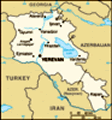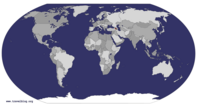Advertisement
Published: December 5th 2008
St. Petersburg - again
St. Petersburg is a large and expensive city. The central area is quite beautiful with beautiful 18th century European architecture along canals reminiscent of Venice. Most of the people live in the “bedroom” communities—regions of Soviet-style large brick or cement (! crumbling) apartment building complexes serviced by the metro system, buses, and “marchroutkas” (minivans). And that is where I lived—a 25 minute walk from the Ploshad Muzhestvo metro station ( Square of Courage —a metro station dedicated to those who defended Leningrad during WWII). From my metro station to the Botanical Institute required only one transfer but the trip took between 45 minutes and one hour. I bought my groceries at a new large supermarket, Prisma, which I found near the Metro station at the Moscow Hotel where I had my Russian lesson. Prisma is a Finnish owned supermarket with wonderful Finnish yogurts, rye breads and Finn Crisps, cheeses, candies etc. But for vegetables I shopped at my neighborhood vegetable stand where the woman owner gave me informal Russian lessons when I purchased vegetables and herbs that I didn’t recognize but wanted to try. My actual Russian teacher met me three days/week in the second level
no-smoking lobby of the newly renovated Moscow Hotel. It was a wonderfully quiet place because there were almost no non-smokers at the hotel using the space at 9 am. A benefit of this particular place for me was the McCafe (McDonald’s) next door that had free wireless internet. So with a cup of McDonald’s coffee (40 rubles) I could check my email in a very clean and comfortable place.
There has been and continues to be a huge influx of government funds into the infrastructure of the city. Paint, pavement, water and sewer renovations are underway everywhere but still, to me, it is a city that is so big it is impossible to move masses of people efficiently using current mass transit systems in combination with thousands of cars. The word “propka” - traffic jam is explanation enough for why people get to work at 11 am and then don’t leave until beyond the peak traffic between 5-8 p.m. or, in fact, many people work at home for several days of the week. Of course many people at the institute work at home because their salaries are impossibly low and they have additional jobs or just try to minimize
the expense of travel to/from work. The thousands of workers hired to make repairs in St. Petersburg, by the way, are guest workers from Tajikistan, Armenia, Kirghistan, and other former Russian republics where men need work.
Fulbright Research Grants are wonderful but not at all lucrative. The grants allocate $600 for housing for St. Petersburg. This is not enough to rent an apartment anywhere in the city of course. My apartment—a one room studio was $700/month plus electricity. For that rate I had to be almost at the end of the metro line, no internet, and no cable TV. The level of funding support meant that eating out in this very expensive city was tricky—there are places where it is possible to eat lunch for under $10.00. One of my favorite places, partly because of the name, but also because it was cheap and delicious food, was Frikadelki (“Meatballs”—in several languages I think). It is right down town off Nevsky Prospect, the main boulevard—near everything. I loved the “Coffee House” cafes for the Russian spelling of the name but they don’t have free internet so I knocked them off my list --and they are expensive.
One of the
friends that I made in St. Petersburg, Alexander, works full-time now as a plant taxonomist at the Botanical Museum in Helsinki. To take a break from my St. Petersburg routine I took the train to Helsinki where I stayed in the small apartment that the Museum owns on the University Campus right in their botanical garden. It was so roomy compared to my St. Petersburg home and the buses to town (a five minute walk away) run exactly on time and go straight to the Helsinki train station which is also right down town. I include a picture of the herbarium cabinets in the Botanical Museum there to show that they are decorated with beautifully detailed wood carvings. The Finnish people seem to have an eye for elegant simplicity. The Herbarium in Helsinki has the world's largest collection of apomictic plant species (those that reproduce asexually) - with more than 300,000 examples.
Alexander gave me books to read about Finnish history and ethnography to show that the Finns are not Scandinavians. Their language belongs to the Finnish-Ugric group0 which means it is related to Hungarian. From Helsinki I signed up for a day tour of Talinn, Estonia (just
a 2 hour ferry ride away) and learned that Estonian also belongs to this language group. Finns and Estonians can understand each other pretty well when they speak their respective languages. Talinn was a pleasant surprise. There is the old city, an interesting and beautiful walled city that was fortified during the period of its membership in the Hanseatic League in centuries past (15th?) and then the new city with a fantastic new Art Museum that just opened this year (photo). The Estonians, my guide was enthusiastic about this, are so happy to be independent and to have their harbor back—during Soviet times they weren’t allowed to go to the sea or use it. And they are so pleased to be associated with western Europe and the US. I wish them well.
I include in this blog the front page photo from the Metro newspaper, the free paper that is handed out for metro users every weekday morning—it says “Goodby Bush”. And another photo from my Russian TV station evening talk show—experts talk about a theme and people can call in and make comments. The theme this particular evening is “Can we conquer America?” I can understand about 50%
of the news—they talk really fast but generally the conversation in this particular talk show focussed on economic and market issues but there was a bit of an undercurrent in the discussions that the US is in disarray in every sense and that Russia is politically and economically quite strong. Because Russia had reserves of funds from oil production and sales the government was assuring everyone that the economy was doing great in this crisis. However, the theme of this very same show the next time was “Return to destitution?” and it was about the pension program in Russia. This time the tone was extremely pessimistic about the future of the Russian pension system. Even now pensioners receive somewhere between 5000 and 8,000-10,000 rubles per month (about 27 rubles/dollar) which is much better than a few years ago but still very difficult. My Russian landlord was also pessimistic—he was in charge of pension funds and investments at a Russian bank and lost his job while I was there. He quit because he had been asked to take a 40% pay cut and then fire 50 of his employees. I include a photo of Russian pensioners lining up to get milk
from a milk truck that pulled up to my apartment yard. They prefer to buy from the tank rather than the store because it is a few rubles cheaper (and perhaps because it is reminiscent of Soviet times which may have been financially better for older people). The government frowns on these milk tanks for hygienic reasons but my Russian teacher said that people protested that they wanted them so they are no longer illegal.
I have included several photos of wonderful cultural activities in St. Petersburg. I include a photo of the wonderful Maryinsky Theater where I saw several operas. It was really great for me because I could actually understand the Russian language on the digital reader above the stage so it was easy to follow the story (Turandot e.g.). The Philharmonic Hall, which is right downtown, has wonderful symphony programs so I spent many evenings there. And I saw a performance of the Magic Flute at the very new Concert Hall near the Maryinsky. It is an acoustically fantastic "theater in the round" style hall.
So my Fulbright experience was interesting, productive, lonely, and damp. I was there 90 days, two of them without rain
or snow. I am so grateful for Yerevan sunshine and for Yerevan’s very modern airport where all 10 passport control booths are in operation when a plane arrives. It takes no more than ten minutes to get through the passport control. The day I arrived in St. Petersburg in early September there were 50 young Tajik men in the line ahead of our plane and only two passport control agents working. I, along with everyone else on my plane, waited 1.5 hours while they processed these guys. By that time there were additional passengers waiting behind us.
I will continue to revise and improve the translation of the botany book. I come back equipped with scanned copies of botanical and geographical dictionaries. There is still plenty of work to be done.
Advertisement
Tot: 0.079s; Tpl: 0.015s; cc: 9; qc: 28; dbt: 0.0389s; 1; m:domysql w:travelblog (10.17.0.13); sld: 1;
; mem: 1.1mb
















Tom Lyman
non-member comment
Terrific Blog!
This has to be one of the very best blogs from Russia. Really gives a sense of being there in St. Petersburg. Thanks for the tour!